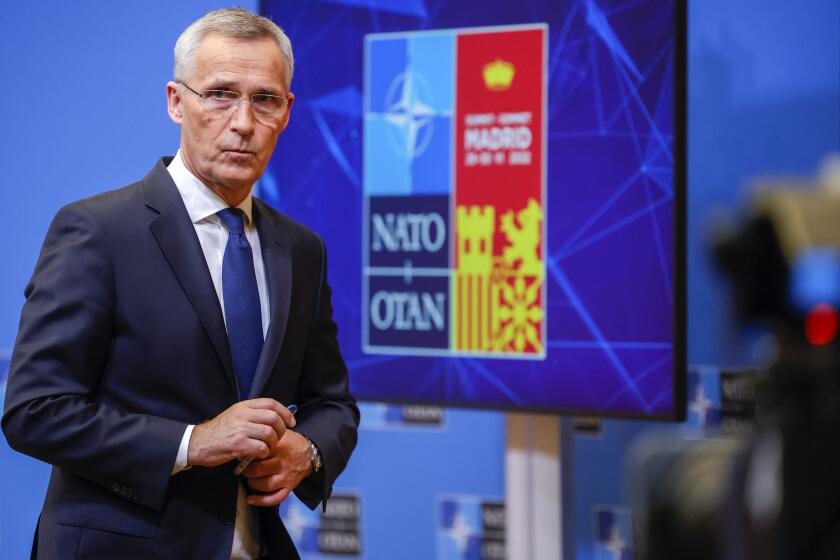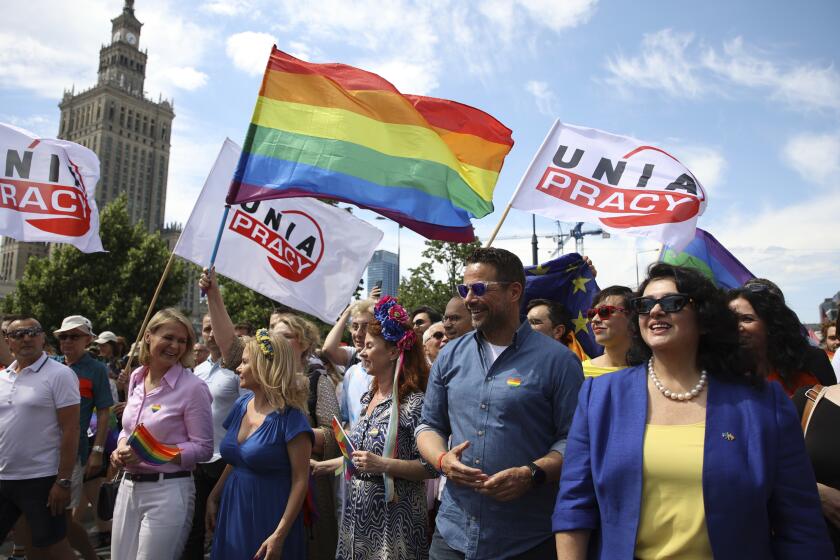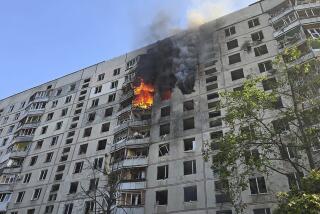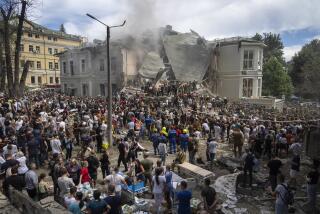Russian missiles strike Odesa area in southern Ukraine, killing at least 21
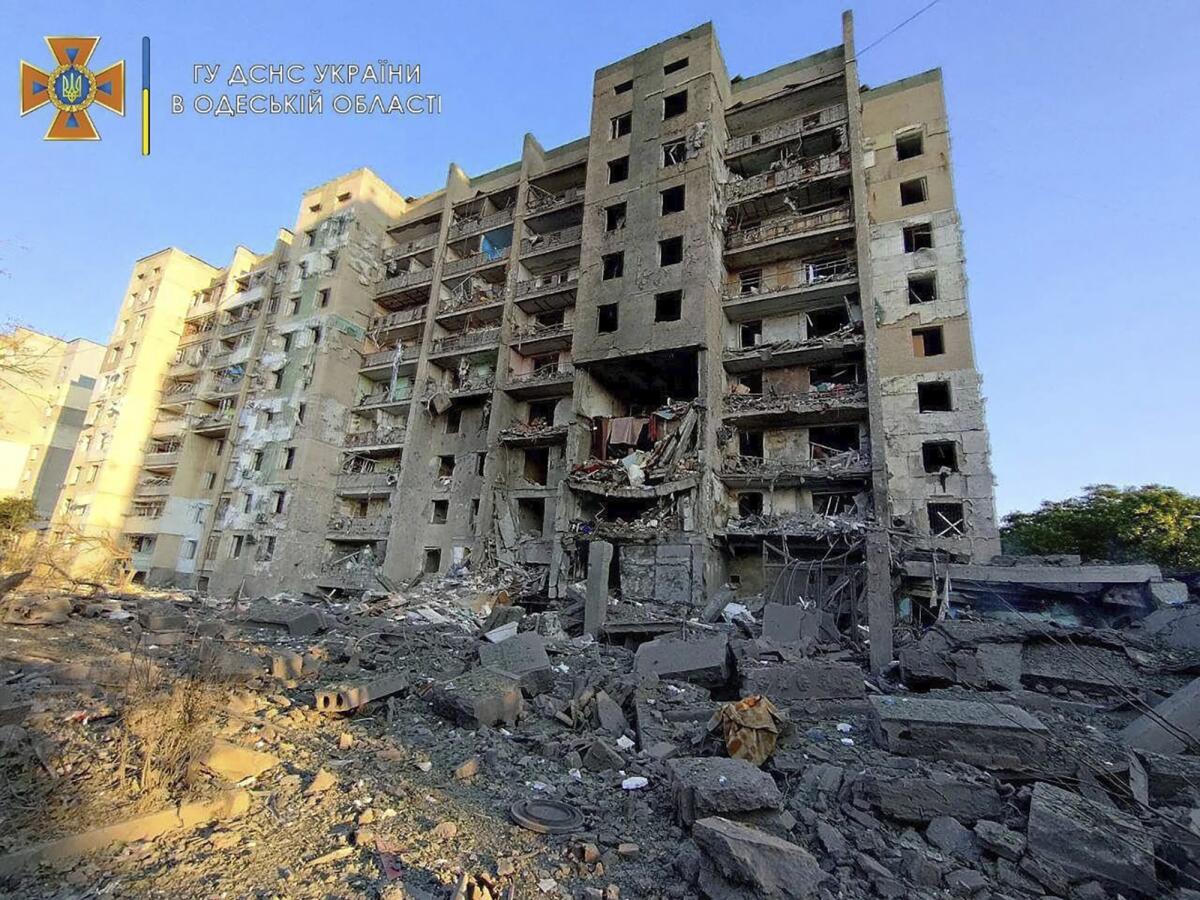
- Share via
POKROVSK, Ukraine — Russian missile attacks on residential areas killed at least 21 people early Friday near the Ukrainian port of Odesa, authorities said, a day after the withdrawal of Moscow’s forces from an island in the Black Sea seemed to ease the threat to the city.
Video of the predawn attack showed the charred remains of buildings in the small town of Serhiivka about 30 miles southwest of Odesa. The office of Ukrainian President Volodymyr Zelensky said three Kh-22 missiles fired by Russian bombers struck an apartment building and a campsite.
Ukrainian authorities interpreted the attack as response for Russian troops being forced from Snake Island a day earlier. Though Moscow portrayed its departure as a “goodwill gesture” to help unblock exports of grain from the country, Ukraine said Russia’s forces fled because of relentless attacks by the Ukrainian military. Russian forces took control of the island in the opening days of the war in the apparent hope of using it as a staging ground for an assault on Odesa, Ukraine’s biggest port and the headquarters of its navy.
“The occupiers cannot win on the battlefield, so they resort to vile killing of civilians,” said Ivan Bakanov, head of Ukraine’s security service, the SBU. “After the enemy was dislodged from Snake Island, he decided to respond with the cynical shelling of civilian targets.”
Ukraine’s military reported late Friday on social media that two Russian Su-30 warplanes bombed Snake Island with phosphorus bombs. Black-and-white aerial video showed two blasts hitting the island. The warplanes reportedly struck from the east, from Belbek, on the Russian-occupied Crimean peninsula. The Russian military did not immediately comment.
Large numbers of civilians died in Russian strikes and shelling earlier in the war, including at a hospital, a theater used as a bomb shelter and a train station. Until this week, mass casualties involving residents appeared to become more infrequent as Moscow concentrated on capturing eastern Ukraine’s Donbas region.
But Russian missiles struck the Kyiv region last weekend after weeks of relative calm around the capital, and an airstrike Monday on a shopping mall in the central city of Kremenchuk killed at least 19 people.
Relentless Russian artillery barrages have battered Ukraine’s powerful coal industry and endangered miners working underground. “No one wants to risk getting trapped down there,” said one.
A U.S. Defense official said Friday in Washington that Russian forces appeared to use an anti-ship missile in the mall attack, a type of weapon that he said is not accurate against land targets. Russia’s Defense Ministry spokesman said earlier this week that warplanes fired precision-guided missiles at a depot that contained Western weapons and ammunition, which detonated and set the mall on fire. Ukrainian authorities said that in addition to the direct hit on the mall, a factory was struck, but denied it housed weapons.
Zelensky said that, as in Monday’s shopping mall attack in Kremenchuk, Russian forces on Friday appeared to use anti-ship missiles to hit Serhiivka.
“These missiles, Kh-22, were designed to destroy aircraft carriers and other large warships, and the Russian army used them against an ordinary nine-story building with ordinary civilian people,” he said at a news conference Friday.
Twenty-one people — including an 11-year-old boy, his mother and the 42-year-old coach of a children’s soccer team — were killed and 38 others, including six children and a pregnant woman, were hospitalized, Ukrainian officials reported. Most of the victims were in the apartment building.
Asked about Friday’s strike, Kremlin spokesman Dmitry Peskov reiterated Moscow’s claim that it wasn’t targeting residential areas during the war, which is now in its fifth month. The Russian military is trying to strike munitions depots, weapon repair factories and troop training facilities, he said.
Oleh Zhdanov, an independent Ukrainian military analyst, said that the Russian departure from Snake Island has “colossal psychological significance” for Ukraine.
“Snake Island is key for controlling the Black Sea and could help cover the Russian attack if the Kremlin opted for an amphibious landing operation in Odesa or elsewhere in the region,” he said. “Now those plans are pushed back.”
NATO Secretary General Jens Stoltenberg says the alliance wants to increase the size of its rapid-reaction forces from 40,000 to more than 300,000.
Ukraine’s military said that a barrage of its artillery and missiles forced the Russians to flee in two small speedboats. The exact number of withdrawing troops was not disclosed.
The island took on significance early in the war as a symbol of Ukraine’s resistance to the Russian invasion after Ukrainian troops there reportedly responded with defiance to a demand from a Russian warship to surrender or be bombed.
Zelensky said that although the pullout did not guarantee the Black Sea region’s safety, it would “significantly limit” Russian activities there.
“Step by step, we will push [Russia] out of our sea, our land, our sky,” he said in his nightly address.
Start your day right
Sign up for Essential California for the L.A. Times biggest news, features and recommendations in your inbox six days a week.
You may occasionally receive promotional content from the Los Angeles Times.
In eastern Ukraine, Russian forces kept up their push to encircle the last stronghold of resistance in Luhansk, one of two provinces that make up the country’s Donbas region. Moscow-backed separatists have controlled much of the region for eight years.
Luhansk Gov. Serhiy Haidai said the Russians were trying to encircle the city of Lysychansk and fighting for control over an oil refinery on the city’s edge.
“The shelling of the city is very intensive,” Haidai said. “The occupiers are destroying one house after another with heavy artillery and other weapons. Residents of Lysychansk are hiding in basements almost round the clock.”
The offensive has failed so far to cut Ukrainian supply lines, although the main highway leading west was not being used because of constant Russian shelling, the governor said. “The evacuation is impossible,” he added.
KyivPride moved to Poland this year and was a platform to keep international attention focused on Ukraine’s struggle against Russia.
But Russian Defense Ministry spokesman Igor Konashenkov said Friday that Russian and Luhansk separatist forces had taken control of the refinery as well as a mine and a gelatin factory in Lysychansk “over the last three days.”
Zelensky’s office said a series of Russian strikes in the last 24 hours also killed civilians in eastern Ukraine — four in the northeastern Kharkiv region and four more in Donetsk province.
In other developments, Zelensky asked Ukrainian lawmakers to fast-track the legislation needed for the country to join the European Union. His government applied for EU membership after Russia’s Feb. 24 invasion. EU leaders made Ukraine a candidate for membership last week, acting with unusual speed and unity.
The process could take years or even decades, but Zelensky said in a speech to lawmakers that Ukraine can’t wait.
“We needed 115 days to receive the status of a EU candidate. Our path to a full-fledged membership mustn’t take decades,” he said. “You may be aware that some of your decisions will not be met with applause, but such decisions are necessary for Ukraine to advance on its path forward, and you must make them.”
In Berlin, Germany’s Cabinet on Friday launched the process of ratifying Sweden and Finland’s NATO membership bids in what government spokesman Steffen Hebestreit called “a clear signal” of support. The parliaments of the alliance’s 30 member nations must ratify the bids, which were announced during a NATO summit this week after Turkey lifted its opposition.
More to Read
Sign up for Essential California
The most important California stories and recommendations in your inbox every morning.
You may occasionally receive promotional content from the Los Angeles Times.

